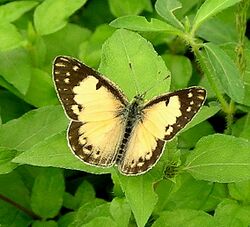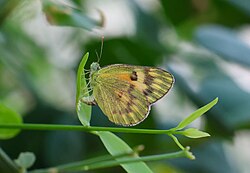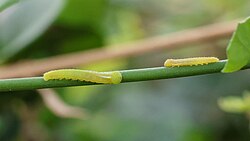Biology:Colotis amata
| Small salmon Arab | |
|---|---|

| |
| Scientific classification | |
| Domain: | Eukaryota |
| Kingdom: | Animalia |
| Phylum: | Arthropoda |
| Class: | Insecta |
| Order: | Lepidoptera |
| Family: | Pieridae |
| Genus: | Colotis |
| Species: | C. amata
|
| Binomial name | |
| Colotis amata (Fabricius, 1775)
| |
| Synonyms | |
| |
Colotis amata, the small salmon Arab,[2][3] is a small butterfly of the family Pieridae, that is, the yellows and whites. It is found in Africa and Asia.[2][3] Adults are fond of smaller flowers for nectar and often fly low along the ground in search of wildflowers.
Description
The male's upperside has a salmon-pink ground colour. The costa on the forewing is black and thickly overlaid with greyish or pinkish scales; a black spot at apex of cell, which may be large and quadrate or smaller and lunate; termen broadly black, with an enclosed double transverse series of spots of the ground colour the inner series consists of a large spot in interspace 1, two very small spots in interspaces 2 and 3, one in each, and four larger anterior spots placed in a curve; the spots in the outer series are variable in number, but generally there is one in each interspace, these are more or less linear in shape. Hindwing: a band on costal margin extended to just within the upper margin of the cell, covered with dense black specialized scales; this black band joined onto a broad similarly coloured terminal band of ordinary scales, that becomes more or less diffuse and powdery posteriorly, and encloses a double series of small spots of the ground colour the inner series often obsolescent, in some specimens entirely absent; dorsum heavily irrorated with fuscous scales, the irroration extended onto the disc, which has therefore generally a greyish appearance.[4] thumb|left|Ventral view
Underside: greenish yellow; an anteciliary fine black line on both forewing and hindwings; the black markings of the upperside show through by transparency. Forewing: a black spot, variable in size and intensity, in some specimens absent altogether, at apex of cell; a subterminal quadrate black spot in interspace 1 and another (sometimes faintly marked or absent) further outwards in interspace 2; disc faintly, dorsal margin broadly very pale salmon pink. Hindwing: the whole surface sparsely irrorated with minute black scales; a small black discocellular spot. Cilia of both forewings and hindwings pale salmon pink. Antennae, head, thorax and abdomen black, the antennae speckled with white, the head and thorax covered with greenish-fuscous hairs; beneath: the palpi green, thorax and abdomen white.[4][1] The female is polymorphic. Form 1. Upperside: ground colour paler than in the male, in some specimens quite ochraceous outwardly; all the markings similar, but duller in tint. The hindwing, of course, without the black costal band of specialized scales, the ground colour extended up to the costal margin. Underside similar to that of the male, but the ground colour very much paler and more ochraceous than green. In some specimens, in addition to the black spots in interspaces 1 and 2 on forewing, there is an anterior postdiscal fuscous curved band. Hindwing: discocellular spot larger than in the 3 and annular; a curved discal series of reddish spots from costa to dorsum.[4] Form 2. Similar to female form 1, but the ground colour pale primrose yellow to pure white. Antennae, head, thorax and abdomen in both forms much as in the male.[4]
Life history
Larva: "Very like that of Eurema, cylindrical or slightly depressed with a rough surface due to minute tubercles, from each of which grows a very small bristle. The colour is a uniform grass-green, with a blue dorsal line more or less distinct, and a yellowish lateral line dividing the colour of the back from the paler green of the underparts." (Davidson & Aitken quoted in Bingham[4])

The caterpillars feed on Salvadora trees, especially Salvadora persica. Since Salvadora persica grows readily in saline lands, these butterflies are often abundant along the coastal areas and tidal mudflats in India . Small salmon Arab and white Arab (Colotis vestalis) are often common butterfly species in the tidal areas of Gujarat, where butterfly diversity is naturally low because of the lack of plant diversity.
Pupa: "Compressed; wing-cases produced into a keel like that of Eurema. It is suspended in the same manner by the tail and a moderately long band. The colour is usually some shade of dingy whitish brown or dirty green." (Davidson & Aitken quoted in Bingham[4])
Subspecies
- C. a. amata (western, southern and central India Africa)
- C. a. calais (Cramer, 1775) (Mauritania, northern Senegal, Gambia, Mali, north-eastern Nigeria, Niger, Zambia, northern Botswana, Zimbabwe, Mozambique, Eswatini, South Africa, southern Arabia)
- C. a. crowleyi (Sharpe, 1898) (Madagascar)
- C. a. modesta (Butler, 1876) (Sri Lanka)
- C. a. williami Henning & Henning, 1994 (central and northern Namibia)
Gallery
At Vikhroli, Mumbai
See also
- List of butterflies of India
- List of butterflies of India (Pieridae)
References
- ↑ 1.0 1.1 Swinhoe, Charles (1905–1910). Lepidoptera Indica. Vol. VII. London: Lovell Reeve and Co.. pp. 143–144. https://www.biodiversitylibrary.org/item/103631#page/157/mode/1up.
- ↑ 2.0 2.1 Varshney, R.K.; Smetacek, Peter (2015). A Synoptic Catalogue of the Butterflies of India. New Delhi: Butterfly Research Centre, Bhimtal & Indinov Publishing, New Delhi. pp. 75. doi:10.13140/RG.2.1.3966.2164. ISBN 978-81-929826-4-9. https://www.researchgate.net/publication/287980260.
- ↑ 3.0 3.1 Savela, Markku. "Colotis amata (Fabricius, 1775)". http://www.nic.funet.fi/pub/sci/bio/life/insecta/lepidoptera/ditrysia/papilionoidea/pieridae/pierinae/colotis/#amata.
- ↑ 4.0 4.1 4.2 4.3 4.4 4.5
 This article incorporates text from a publication now in the public domain: Bingham, C.T. (1907). The Fauna of British India, Including Ceylon and Burma. II (1st ed.). London: Taylor and Francis, Ltd.. pp. 261–263. https://archive.org/stream/butterflies02bingiala#page/260/mode/2up/.
This article incorporates text from a publication now in the public domain: Bingham, C.T. (1907). The Fauna of British India, Including Ceylon and Burma. II (1st ed.). London: Taylor and Francis, Ltd.. pp. 261–263. https://archive.org/stream/butterflies02bingiala#page/260/mode/2up/.
Wikidata ☰ Q2291101 entry
 |







